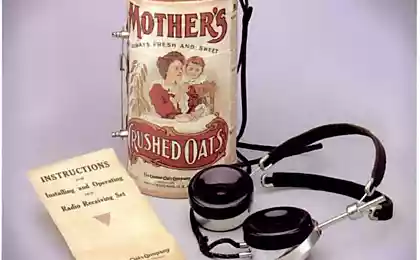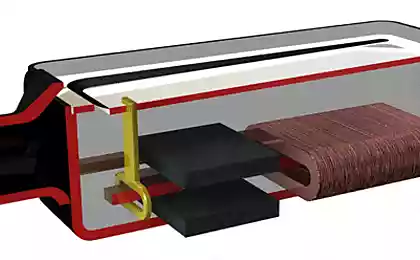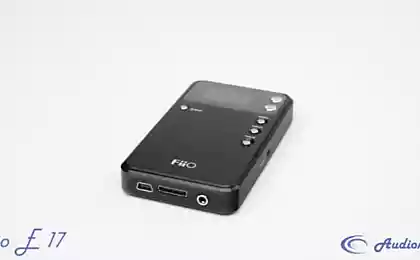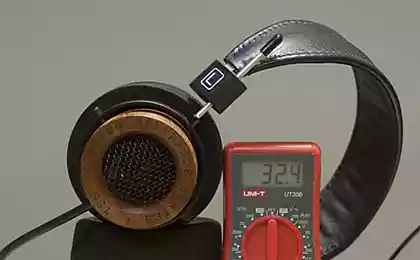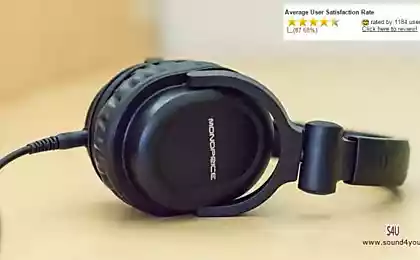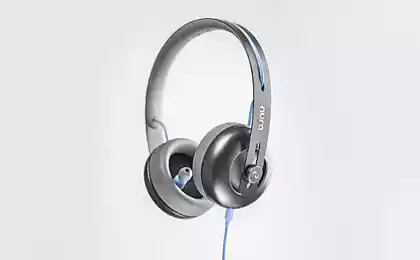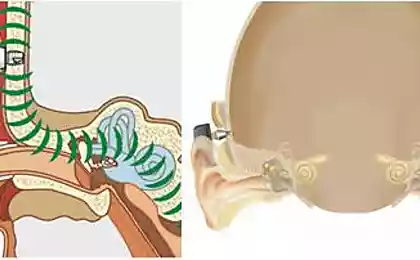1695
In-ear monitor: all of them
1. What is IEMs?
In-ear monitor (Engl. In-Ear-Canalphone), still referred to as a gag, less ear monitors, or (right) IEMs em> (later in the article is this name, because it is very succinct and like the author) - a headphone that looks very similar to the ear, but designed for maximum soundproofing ear canal of the listener. Her (soundproofing) is called, the sound "sealing", - it has two functions: blocking unnecessary noise and the formation of a sound area (camera) to achieve a rich sound. It creates a sealing nozzle, put on nozzle and earpiece embedded in the front part of the ear canal. There are also headphones, where the nozzle is created by the owner casts ears - they are called (from the Russian-speaking audience) kastomov (Eng. Custom molded earplugs a >) - these things are to achieve maximum sound quality and comfort of listening.
Why choose IEMs em>? Because of the high portability, high-quality sound and the ability to lock the extra noise. Some models are already using audio engineers; musicians, performing on stage. Gag (in Russia, the name stuck more) are a kind of IEMs em>. When the in-ear monitor manufacturers began to rivet them to the general user (generation iPod), the abbreviation IEMs em> has become more popular (not in Russia), by replacing the term "fillers". Technical language correctly "gag" call - IEMs em>. Less common abbreviation for IEMs em> is used to denote high quality in-ear monitor.
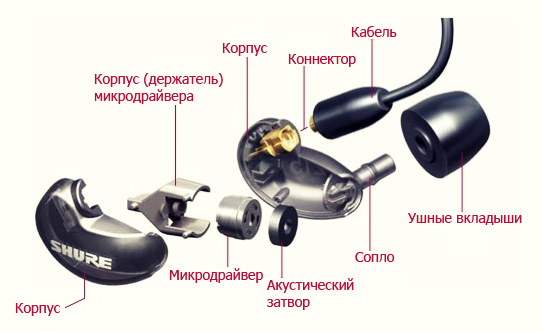
Fig. 1. The main components of IEMs.
em> 2. IEMs - it inserts? Em> No. IEMs em> and inserts (Eng. earbuds em>) refer to the two main, but different types of inner ear headphones (Eng. in the earphones em>). In the second converters are small enough to be fixed tightly in the ear, and as a consequence, they are not "sealed."
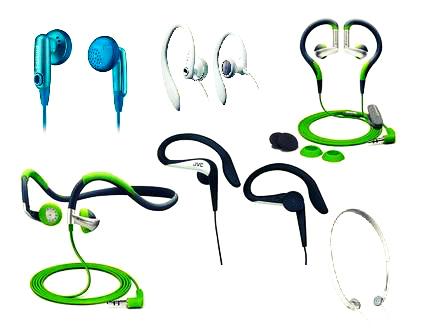
Fig. 2. Different types of inserts. Em>
Inserts and plugs are worn as open headphones, often outside of the ear canal. They can be mounted on the rim of the head, or a clip (clip) for greater comfort.
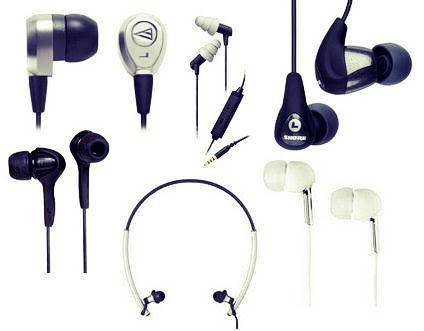
Fig. 3. Different types of IEMs. Em>
Only the IEMs em> are designed for partial installation in the ear canal to create a "hermetic" seal. Previously, the majority (sites, shops, the people) because of their lack of understanding often confuse two completely different types of headphones.
3. Noise and Noise Reduction
Despite its large size, with active noise cancellation headphones ( Eng. ANC em>) is not always insulate against noise better than IEMs em>. Also in the ANC em> the sound quality ( Eng. SQ em>) is often second-class or even lower (although much depends on the price, but still). There are a number of studies from Auditory Systems Lab (Virginia Tech University) em> that worked on the matter and came to this conclusion.
4. Types of converters
There are two main converter (transducer drivers) which are used in the IEMs: Dynamic em> and with a balanced armature em> ( English. BA em>; in Russia - fittings ).
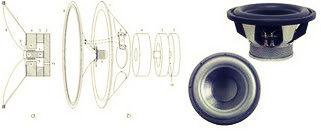
Fig. 4. Dynamic Converter. Em>
Dynamic Converter (moving coil) is often found in the IEMs em> lower class due to its simplicity and low cost, in contrast to the "reinforcement". Typically, the first size is much smaller and range from 3 to 6 mm in diameter. Dynamic Converter is known for its ability to create a more powerful bass, as During playback, the sound it moves more air, because of the available space (than can not boast of "reinforcement" headset with several inverters) is felt by the human ear. It is worth noting that part of the well-known manufacturers use in their dynamic inverter models IEMs em>, but the sound quality is relatively low, and this should be remembered.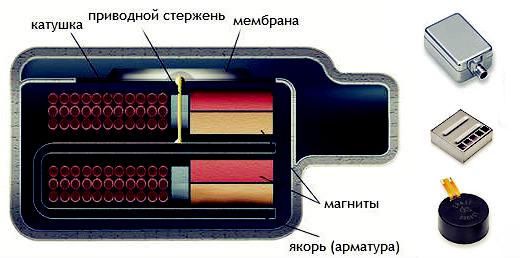
Fig. 5. Dynamic transducer (inside and outside). em>
Reinforcing headphones have the advantage - fidelity in them is much higher for the frequency range less to remove this disadvantage, they use several dynamic transducers in each earpiece, which solves this problem, each driver operates in its frequency range, increasing overall range , thereby aligning the AFC. The disadvantage of headphones with multiple converters is their high price and large size.
5. Nozzles

Fig. 6. Options nozzles on the headphones. Em>
The headphones type IEMs em>, as a rule, can occur three types of attachments: soft plastic ( Eng. Flanges, sleeves em>), foam ( Eng. Foam em> ) and arbitrary shapes ( Eng. mold em>) with a hard acrylic or soft silicone material (there is also a hybrid, soft and hard forms, but rarely).
Soft plastic nozzles are of two types: universal ( Eng. Universal em>) and razmerozavisimye ( Engl. Size-depended em>). Universal are two or three projections, it allows you to insert them into your ears to the required depth, reaching the proverbial "integrity." Most headphones with such attachments troublesome influence their listeners. Razmerozavisimye attachment of soft plastic more comfortable, because they have three sizes: small, medium and large. The user chooses what suits his size ears.
Highest "sealing", and as a result the best comfort and insulation from foam nozzles. This form gives a full, warm and pleasant sound than the plastic or silicone. Foam nozzles also have two types of related size. It should be noted that this type of nozzle can not be cleaned and must be replaced after several weeks of use. Some manufacturers even produce similar nozzles (with different types of foam) for separate sale, in addition to the standard.
Black foam packing from the company «Shure» are the most popular [not advertising] market and provide greater comfort, based on the (subjective) experience. Most models have a size that indicates the point below the earphone: one point - a small, two points - the average, three points - great. Manuals are always supplied with the headphones.
6. The size of nozzles
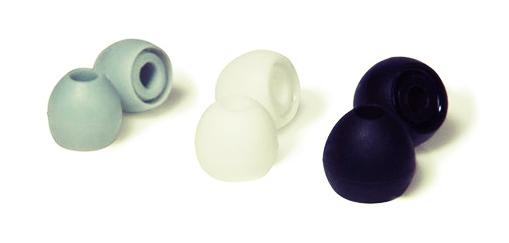
Fig. 7. Bits of various sizes. Em>
The correct choice of the size of the nozzle provides the perfect "encapsulation", which in turn leads to the maximum comfort and excellent sound. Using a large nozzle will cause pain in the ear after a few days, as a result of the use of small size is the lack of sound insulation, and the predominance of high frequencies, due to air leakage.
Sometimes a man for a long time can not find the right size of the nozzle, for some ears are very sensitive to foreign bodies. In this case, you will need to follow a few tips to reduce discomfort from this problem.
7. Bits: comfort factor
We stopped at the "sealing", comfort and sound quality silicone and plastic nozzles (about the foam will not say anything, because they are very comfortable and deliver the very lowest part of the discomfort the audience). Consider some of the factors.
Factor 1: partial and full planting em>
Some headphones (for example, and ) allow full, but do not insert the nozzle deeply in the ear (about 8-9 mm), which will create less isolation, but more comfort for the user. 88,890,594
Fig. 8. Creative EP-630 and Sennheiser CX 300, respectively. Em>
Most of the rest of headphones require the listener deeper insertion (more than 9 mm). Such planting, as already mentioned, will create a good seal is therefore better "seal" as a result of sound insulation, but at the expense of convenience.
Factor 2: The material nozzle em>
Often, the nozzle is made of soft plastic, silicone or PVC. Silicone is the softest of all the nozzles, as a consequence of a more convenient, but not all silicone nozzles have the same softness.

Fig. 9. Nozzles made of soft plastic, silicone and PVC, respectively.
Factor 3: the thickness of the nozzle em>
A simple rule, which states that the thinner the material will be on the nozzle, the better, but again at the expense of sound insulation.
Factor 4: Design tips em>
Location converter also plays an important role. In general, if it is hidden compact, which will have an earpiece small size, it is good. That is why the headset with several converters are considered inconvenient.

Fig. 10. Headphones Ultimate Ears series and (with a few converters), respectively.
The factors on visual examples em>
Example 1: headphones with a single nozzle - shallow planting, hard and thick tips large size headphone = not very comfortable, but the good insulation.
Example 2: headphones single-nozzle - no deep planting, soft, thin, small size earphone = comfortable, noise isolation average.
Example 3: headphones triple nozzle - deep planting, soft and thick, a small earphone - not so comfortable, but a great noise isolation.
Example 4: headphones double nozzle - deep planting, soft, slightly porous medium nozzle thickness, a small earphone = convenience and a great noise isolation.
Example 5: headphones double nozzle - deep inset, the average softness and thickness, small size earphone = excellent facilities and a good shumoizolyatsiya.
Fig. Headphones according to Example 11. Em>
It is important to remember that always takes time to get used to a particular nozzle, so decisions do not need to rush. Personal preferences in sound change more frequently than in convenience and it should also be taken into account. It also happens that a man falls in love with the sound, regardless of the inconvenience, after, when the euphoria of the sound is lost, forgotten come to him concern.
9. Maintain the appearance and care
Maintaining a set of headphones in a decent appearance can enhance the quality of the original "seal" and the life of the headphones. First of all, remember that there is no better way to save the life of headphones than regular cleaning of the ear canal.
For universal headphone pollution nozzles promises to excess noise and poor sound quality because debris contributes to a misallocation of the air. To avoid this, you should either change the nozzle with new ones or use special tools for cleaning.
Clean the headphones cable is not less than once a month. If you exercise in the headphones, it should be done more often, especially in those areas where the wire touches the skin. This will make your headphones more durable.
Do not Do not use alcohol or cleaning fluid and bleach. Just use a damp cloth and soap.
To clean the nozzles, carefully remove them from the headphones. To do it properly without damaging them, take a tip with thumb and forefinger and twisting movements pull it out of the nozzles of the converter. Do not pull the nozzle, as this often leads to rupture and damage.
Remember that the cable from the headphone jack, as well as any other cable ogrubevaet and eventually crack. The more you take care of your headphones, the longer they will serve you. However, different manufacturers use different cable qualities: looks flimsy and quality cable is sometimes very strong, and sometimes the situation is completely the opposite yes. Ideally, in the long term is better to use a removable cable; everything a quality (very) detachable cable can enhance the sound quality.
Bits of soft plastic is recommended to wash in warm, soapy water. Be careful not to allow any moisture even once soaking the headphones, you will not be able to properly repair them to a previous state. If you still wet the headphones, it is recommended to leave them in a ventilated room for 1 - 2 days - it helps moisture to evaporate.
Always wait for the complete drying of headphones before you put them in your ear.
It has been experimentally revealed that when cleaning nozzles headphone hydrogen peroxide (15 minutes in the fluid) the battery life increases significantly.
9. Static electricity
Using earplugs are available electrostatic discharge.
In cold conditions with low humidity, a static charge can build up on the body, although only the ears touch headphone plastic parts, there are metal parts, which are adjacent; a static charge, which usually has a high voltage is able to jump from one place to another. If you reach the charge, it will not hurt you, though, and bring discomfort.
It is important to note that these discharges are quite rare, and do not mean that your headphones are defective; If you are regularly subjected to electric shocks, it is likely you have damaged the cable (sheath), and it is a warranty case.
10. Warming (Eng. Burn-it) IEMs
There is no definitive answer, yes or no. General theme warming has little religious in nature and are mainly still answer - no, although there are people (if you look at the discussion forums) and even the tests, where IEMs em> did show signs of improvement after the warm-up.
In general, it is very easy to verify, because the duration of the warm-up at the IEMs em> is much less than any other headphones to a maximum of a couple of days (or rather, no more than 50 hours) of random music playback at normal volume.
11. Noise from Cable (Eng. Cable noise) and movement of the body (Eng. Bone conduction)
Most of the owners demanding IEMs em>, you can hear the complaints of two types, - when the user hears the unpleasant noises caused by vibrations IEMs em>, which touch the clothes or other objects; the second - if translated literally, it would sound like "bone conduction" - a phenomenon that when the noise in the headphones (occurring within the body) occurs when walking, running, eating food and so forth.
To solve the first problem is to purchase the clip (preferably not one) and how to attach the cable. There are also special cables, which is indifferent to the fact hurt him or not. Often, even in the top headphone cable can be found of poor quality, so in this matter, before buying, it is best to first look thematic forums or listen to "check" the cable so that it satisfies your needs. The second problem for the current day is not resolved, but how the listener gets used to the noise in the background, or walking slowly (to change shoes).
12. Portable Amplifier for IEMs
Do I need a portable amplifier ( English. Portable Amps em>) to IEMs em>? - Yes, in order to sound better, but a small portion of the headphones. Often this high-impedance IEMs em>, for example can be associated with an amplifier, but the gain will SQ hardly noticeable, unless you do not have terrific hearing, or not sick last stage audifilii.
The resistance and sensitivity - the easiest way to determine whether the headphone amplifier is needed - if there are characteristics in less than 50 ohms, and 98 dB, respectively, the IEMs em>, of course, does not require amplification.
13. The hissing and whistling
Sometimes, IEMs-listeners can hear the interference light at low volume, like a hiss. Since most IEMs are very sensitive, they are easy to pick up electrical noise when any other headphones ignore them. There is no actual fix for this issue, but if you add to the incoming line resistor (to increase resistance and reduce sensitivity), then chances are it will work. Some sources (one type of HDD to iPod) produce more electrical noise.
Whistle. IEMs in the frequency range 1KHz ~ 10kHz for some "pings" or "fizzing" is very subjective. The problem seems to be obvious - the headphones produce a very sharp treble that after prolonged listening can be irritating, to bore the listener. Two Solutions - equalizer setting for themselves and (or) selection of other baits filter.
14. The term of service and out-of-warranty cases
Do not think that the $ 500 headphones will serve you 5 times longer than the headphones for $ 100. Average life is usually written in the guarantee provided. Most of the cost - not an indicator of durability.
After the failure, in 90% of cases, the buyer (if breaking the agreement satisfies the conditions of the warranty) provide new headphones because replacing unprofitable manufacturer, because It requires a good technical base, which is often only on the production line.
In general, here it is better to draw an analogy with cars.
href="http://www.ncbi.nlm.nih.gov/pubmed/18230862?ordinalpos=8&itool=EntrezSystem2.PEntrez.Pubmed.Pubmed_ResultsPanel.Pubmed_RVDocSum">1, 2.
Be careful.
In-ear monitor (Engl. In-Ear-Canalphone), still referred to as a gag, less ear monitors, or (right) IEMs em> (later in the article is this name, because it is very succinct and like the author) - a headphone that looks very similar to the ear, but designed for maximum soundproofing ear canal of the listener. Her (soundproofing) is called, the sound "sealing", - it has two functions: blocking unnecessary noise and the formation of a sound area (camera) to achieve a rich sound. It creates a sealing nozzle, put on nozzle and earpiece embedded in the front part of the ear canal. There are also headphones, where the nozzle is created by the owner casts ears - they are called (from the Russian-speaking audience) kastomov (Eng. Custom molded earplugs a >) - these things are to achieve maximum sound quality and comfort of listening.
Why choose IEMs em>? Because of the high portability, high-quality sound and the ability to lock the extra noise. Some models are already using audio engineers; musicians, performing on stage. Gag (in Russia, the name stuck more) are a kind of IEMs em>. When the in-ear monitor manufacturers began to rivet them to the general user (generation iPod), the abbreviation IEMs em> has become more popular (not in Russia), by replacing the term "fillers". Technical language correctly "gag" call - IEMs em>. Less common abbreviation for IEMs em> is used to denote high quality in-ear monitor.

Fig. 1. The main components of IEMs.
em> 2. IEMs - it inserts? Em> No. IEMs em> and inserts (Eng. earbuds em>) refer to the two main, but different types of inner ear headphones (Eng. in the earphones em>). In the second converters are small enough to be fixed tightly in the ear, and as a consequence, they are not "sealed."

Fig. 2. Different types of inserts. Em>
Inserts and plugs are worn as open headphones, often outside of the ear canal. They can be mounted on the rim of the head, or a clip (clip) for greater comfort.

Fig. 3. Different types of IEMs. Em>
Only the IEMs em> are designed for partial installation in the ear canal to create a "hermetic" seal. Previously, the majority (sites, shops, the people) because of their lack of understanding often confuse two completely different types of headphones.
3. Noise and Noise Reduction
Despite its large size, with active noise cancellation headphones ( Eng. ANC em>) is not always insulate against noise better than IEMs em>. Also in the ANC em> the sound quality ( Eng. SQ em>) is often second-class or even lower (although much depends on the price, but still). There are a number of studies from Auditory Systems Lab (Virginia Tech University) em> that worked on the matter and came to this conclusion.
4. Types of converters
There are two main converter (transducer drivers) which are used in the IEMs: Dynamic em> and with a balanced armature em> ( English. BA em>; in Russia - fittings ).

Fig. 4. Dynamic Converter. Em>
Dynamic Converter (moving coil) is often found in the IEMs em> lower class due to its simplicity and low cost, in contrast to the "reinforcement". Typically, the first size is much smaller and range from 3 to 6 mm in diameter. Dynamic Converter is known for its ability to create a more powerful bass, as During playback, the sound it moves more air, because of the available space (than can not boast of "reinforcement" headset with several inverters) is felt by the human ear. It is worth noting that part of the well-known manufacturers use in their dynamic inverter models IEMs em>, but the sound quality is relatively low, and this should be remembered.

Fig. 5. Dynamic transducer (inside and outside). em>
Reinforcing headphones have the advantage - fidelity in them is much higher for the frequency range less to remove this disadvantage, they use several dynamic transducers in each earpiece, which solves this problem, each driver operates in its frequency range, increasing overall range , thereby aligning the AFC. The disadvantage of headphones with multiple converters is their high price and large size.
5. Nozzles

Fig. 6. Options nozzles on the headphones. Em>
The headphones type IEMs em>, as a rule, can occur three types of attachments: soft plastic ( Eng. Flanges, sleeves em>), foam ( Eng. Foam em> ) and arbitrary shapes ( Eng. mold em>) with a hard acrylic or soft silicone material (there is also a hybrid, soft and hard forms, but rarely).
Soft plastic nozzles are of two types: universal ( Eng. Universal em>) and razmerozavisimye ( Engl. Size-depended em>). Universal are two or three projections, it allows you to insert them into your ears to the required depth, reaching the proverbial "integrity." Most headphones with such attachments troublesome influence their listeners. Razmerozavisimye attachment of soft plastic more comfortable, because they have three sizes: small, medium and large. The user chooses what suits his size ears.
Highest "sealing", and as a result the best comfort and insulation from foam nozzles. This form gives a full, warm and pleasant sound than the plastic or silicone. Foam nozzles also have two types of related size. It should be noted that this type of nozzle can not be cleaned and must be replaced after several weeks of use. Some manufacturers even produce similar nozzles (with different types of foam) for separate sale, in addition to the standard.
Black foam packing from the company «Shure» are the most popular [not advertising] market and provide greater comfort, based on the (subjective) experience. Most models have a size that indicates the point below the earphone: one point - a small, two points - the average, three points - great. Manuals are always supplied with the headphones.
6. The size of nozzles

Fig. 7. Bits of various sizes. Em>
The correct choice of the size of the nozzle provides the perfect "encapsulation", which in turn leads to the maximum comfort and excellent sound. Using a large nozzle will cause pain in the ear after a few days, as a result of the use of small size is the lack of sound insulation, and the predominance of high frequencies, due to air leakage.
Sometimes a man for a long time can not find the right size of the nozzle, for some ears are very sensitive to foreign bodies. In this case, you will need to follow a few tips to reduce discomfort from this problem.
7. Bits: comfort factor
We stopped at the "sealing", comfort and sound quality silicone and plastic nozzles (about the foam will not say anything, because they are very comfortable and deliver the very lowest part of the discomfort the audience). Consider some of the factors.
Factor 1: partial and full planting em>
Some headphones (for example, and ) allow full, but do not insert the nozzle deeply in the ear (about 8-9 mm), which will create less isolation, but more comfort for the user. 88,890,594
Fig. 8. Creative EP-630 and Sennheiser CX 300, respectively. Em>
Most of the rest of headphones require the listener deeper insertion (more than 9 mm). Such planting, as already mentioned, will create a good seal is therefore better "seal" as a result of sound insulation, but at the expense of convenience.
Factor 2: The material nozzle em>
Often, the nozzle is made of soft plastic, silicone or PVC. Silicone is the softest of all the nozzles, as a consequence of a more convenient, but not all silicone nozzles have the same softness.

Fig. 9. Nozzles made of soft plastic, silicone and PVC, respectively.
Factor 3: the thickness of the nozzle em>
A simple rule, which states that the thinner the material will be on the nozzle, the better, but again at the expense of sound insulation.
Factor 4: Design tips em>
Location converter also plays an important role. In general, if it is hidden compact, which will have an earpiece small size, it is good. That is why the headset with several converters are considered inconvenient.

Fig. 10. Headphones Ultimate Ears series and (with a few converters), respectively.
The factors on visual examples em>
Example 1: headphones with a single nozzle - shallow planting, hard and thick tips large size headphone = not very comfortable, but the good insulation.
Example 2: headphones single-nozzle - no deep planting, soft, thin, small size earphone = comfortable, noise isolation average.
Example 3: headphones triple nozzle - deep planting, soft and thick, a small earphone - not so comfortable, but a great noise isolation.
Example 4: headphones double nozzle - deep planting, soft, slightly porous medium nozzle thickness, a small earphone = convenience and a great noise isolation.
Example 5: headphones double nozzle - deep inset, the average softness and thickness, small size earphone = excellent facilities and a good shumoizolyatsiya.

Fig. Headphones according to Example 11. Em>
It is important to remember that always takes time to get used to a particular nozzle, so decisions do not need to rush. Personal preferences in sound change more frequently than in convenience and it should also be taken into account. It also happens that a man falls in love with the sound, regardless of the inconvenience, after, when the euphoria of the sound is lost, forgotten come to him concern.
9. Maintain the appearance and care
Maintaining a set of headphones in a decent appearance can enhance the quality of the original "seal" and the life of the headphones. First of all, remember that there is no better way to save the life of headphones than regular cleaning of the ear canal.
For universal headphone pollution nozzles promises to excess noise and poor sound quality because debris contributes to a misallocation of the air. To avoid this, you should either change the nozzle with new ones or use special tools for cleaning.
Clean the headphones cable is not less than once a month. If you exercise in the headphones, it should be done more often, especially in those areas where the wire touches the skin. This will make your headphones more durable.
Do not Do not use alcohol or cleaning fluid and bleach. Just use a damp cloth and soap.
To clean the nozzles, carefully remove them from the headphones. To do it properly without damaging them, take a tip with thumb and forefinger and twisting movements pull it out of the nozzles of the converter. Do not pull the nozzle, as this often leads to rupture and damage.
Remember that the cable from the headphone jack, as well as any other cable ogrubevaet and eventually crack. The more you take care of your headphones, the longer they will serve you. However, different manufacturers use different cable qualities: looks flimsy and quality cable is sometimes very strong, and sometimes the situation is completely the opposite yes. Ideally, in the long term is better to use a removable cable; everything a quality (very) detachable cable can enhance the sound quality.
Bits of soft plastic is recommended to wash in warm, soapy water. Be careful not to allow any moisture even once soaking the headphones, you will not be able to properly repair them to a previous state. If you still wet the headphones, it is recommended to leave them in a ventilated room for 1 - 2 days - it helps moisture to evaporate.
Always wait for the complete drying of headphones before you put them in your ear.
It has been experimentally revealed that when cleaning nozzles headphone hydrogen peroxide (15 minutes in the fluid) the battery life increases significantly.
9. Static electricity
Using earplugs are available electrostatic discharge.
In cold conditions with low humidity, a static charge can build up on the body, although only the ears touch headphone plastic parts, there are metal parts, which are adjacent; a static charge, which usually has a high voltage is able to jump from one place to another. If you reach the charge, it will not hurt you, though, and bring discomfort.
It is important to note that these discharges are quite rare, and do not mean that your headphones are defective; If you are regularly subjected to electric shocks, it is likely you have damaged the cable (sheath), and it is a warranty case.
10. Warming (Eng. Burn-it) IEMs
There is no definitive answer, yes or no. General theme warming has little religious in nature and are mainly still answer - no, although there are people (if you look at the discussion forums) and even the tests, where IEMs em> did show signs of improvement after the warm-up.
In general, it is very easy to verify, because the duration of the warm-up at the IEMs em> is much less than any other headphones to a maximum of a couple of days (or rather, no more than 50 hours) of random music playback at normal volume.
11. Noise from Cable (Eng. Cable noise) and movement of the body (Eng. Bone conduction)
Most of the owners demanding IEMs em>, you can hear the complaints of two types, - when the user hears the unpleasant noises caused by vibrations IEMs em>, which touch the clothes or other objects; the second - if translated literally, it would sound like "bone conduction" - a phenomenon that when the noise in the headphones (occurring within the body) occurs when walking, running, eating food and so forth.
To solve the first problem is to purchase the clip (preferably not one) and how to attach the cable. There are also special cables, which is indifferent to the fact hurt him or not. Often, even in the top headphone cable can be found of poor quality, so in this matter, before buying, it is best to first look thematic forums or listen to "check" the cable so that it satisfies your needs. The second problem for the current day is not resolved, but how the listener gets used to the noise in the background, or walking slowly (to change shoes).
12. Portable Amplifier for IEMs
Do I need a portable amplifier ( English. Portable Amps em>) to IEMs em>? - Yes, in order to sound better, but a small portion of the headphones. Often this high-impedance IEMs em>, for example can be associated with an amplifier, but the gain will SQ hardly noticeable, unless you do not have terrific hearing, or not sick last stage audifilii.
The resistance and sensitivity - the easiest way to determine whether the headphone amplifier is needed - if there are characteristics in less than 50 ohms, and 98 dB, respectively, the IEMs em>, of course, does not require amplification.
13. The hissing and whistling
Sometimes, IEMs-listeners can hear the interference light at low volume, like a hiss. Since most IEMs are very sensitive, they are easy to pick up electrical noise when any other headphones ignore them. There is no actual fix for this issue, but if you add to the incoming line resistor (to increase resistance and reduce sensitivity), then chances are it will work. Some sources (one type of HDD to iPod) produce more electrical noise.
Whistle. IEMs in the frequency range 1KHz ~ 10kHz for some "pings" or "fizzing" is very subjective. The problem seems to be obvious - the headphones produce a very sharp treble that after prolonged listening can be irritating, to bore the listener. Two Solutions - equalizer setting for themselves and (or) selection of other baits filter.
14. The term of service and out-of-warranty cases
Do not think that the $ 500 headphones will serve you 5 times longer than the headphones for $ 100. Average life is usually written in the guarantee provided. Most of the cost - not an indicator of durability.
After the failure, in 90% of cases, the buyer (if breaking the agreement satisfies the conditions of the warranty) provide new headphones because replacing unprofitable manufacturer, because It requires a good technical base, which is often only on the production line.
In general, here it is better to draw an analogy with cars.
href="http://www.ncbi.nlm.nih.gov/pubmed/18230862?ordinalpos=8&itool=EntrezSystem2.PEntrez.Pubmed.Pubmed_ResultsPanel.Pubmed_RVDocSum">1, 2.
Be careful.
